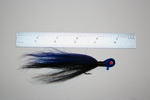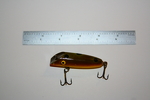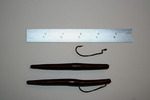On that subject...
in Fishing Video
Pickerel and Pike at Stony Island (video)
I folks, I just had a chance over the... MORE
The Ultimate Fishing Town Contest - vote now!
Hi folks, The World Fishing Network... MORE
2011 Junior Carp Tournament (video)
Hi Folks - we've been working on this video... MORE
Another Nice Muskie on the Grasse (video)
Hi Folks, In our efforts to test the... MORE
Big Muskie on a Float Down the Grasse River (video)
In one of my earlier posts, I mentioned having... MORE
Fishing at Whitehouse Bay, Waddington, NY (video)
A couple of years ago, I had the opportunity to... MORE
One More Chance (Cast): Tales of a Holiday Feast (video)
As I sit here at this keyboard, the wind is... MORE
Fall Surprise (video)
Let’s face it! When the weather gets cold and... MORE
Beauchene Brook Trout (video)
For those of you that have watched my show... MORE
Fishing with Don Meissner Video Series: Using Plastic & Being Flexible
As I have so often raved, the waters of the St.... MORE
Fishing with Don Meissner Video Series: Early Season Largemouth on the St. Lawrence River
In this very first episode of "Fishing with Don... MORE
A Fork in the Road
WPBS, the Public Television station that produced... MORE
Don't miss WPBS-TV tonight: Rod & Reel Streamside Marathon
Tonight on WPBS-TV (Watertown, NY), Don will... MORE
in Fishing Tackle
Fran Betters
I recently learned of the passing of Fran... MORE
Photos from our Trip on the St. Lawrence and St. Regis
Here are some photos from our trip yesterday on... MORE
in Largemouth
Early Season Mixed Bag at Akwesasne (video)
The days are getting longer and the idea of... MORE
Fishing Akwesasne with Will Clute and Dave Swanson (video)
On this day I decided to try some early season... MORE
Fishing for Muskies (that are) Fishing for Smallmouth on the St. Lawrence River
What an incredible day we had last Monday fishing... MORE
in Smallmouth
Cold Weather - Hot Action Smallmouths "Final Update" with Part 7 of the Series (video)
I had an opportunity to spend a day on the water... MORE
Fishing the Grasse River for Smallmouth Bass with Dusan Ducic (video)
One day I had the opportunity to go fishing with... MORE
Don's Muskie on a Bass on a Fly
In this photo at the right, Don holds his nearly... MORE
in Fishing
2011 Wounded Warrior Derby - Ogdensburg (Full Version)
2011 Wounded Warrior Derby - Ogdensburg
Also, you can buy the best crossbow for fishing.... MORE
The Carp Angling World Championship (video)
Hi folks, some of you may already know about... MORE
Fathers Day
This site has given me a fantastic opportunity to... MORE
Saturday, June 21, 2008
This Week's Hot Lures
Here are some hot lures we used during our trip recently, as seen in Episode II of the Fishing with Don Meissner Video Series, Using Plastic and Being Flexible.
1. The white spinner bait
 The example shown was made by Jim Ingram, one of my fishing
accomplices. While the lure is basic, it has so many applications that it
should be part of every angler’s arsenal. As you can see from the photo, Jim
attached a trailer hook to help with short strikes. Notice how the hook is
attached with a short piece of surgical tubing. Take a close look at the way
the tubing is used as it allows the trailer to flex. This helps assures that
each time the fish moves, it can not leverage a rigid hook.
The example shown was made by Jim Ingram, one of my fishing
accomplices. While the lure is basic, it has so many applications that it
should be part of every angler’s arsenal. As you can see from the photo, Jim
attached a trailer hook to help with short strikes. Notice how the hook is
attached with a short piece of surgical tubing. Take a close look at the way
the tubing is used as it allows the trailer to flex. This helps assures that
each time the fish moves, it can not leverage a rigid hook.
The reason that spinner baits are so effective is that they combine lots of flash and sound. It is important that as the bait comes through the water that the skirt and blade lie in a straight line with the blade directly above the skirted hook. The angle of the bend of the wire can have an effect upon how easily the lure runs true. The style of blades will determine the sound the lure makes as well as the amount of flash emitted, but we won’t get too deep into that now.
As you will notice, Jim selected a four inch twister tail to help dress the hook. The gives body to the lure as will as provides more action to the skirt. The white color was a good choice because of the muddy water. It was the only lure we tried that the smallmouths reacted to in those far upstream waters that were most affected by the storm’s runoff.
The technique was simple: cast and retrieve. That is one of the most appealing features of this bait: anyone can catch fish with it. Softer tipped rods are often preferred because the lure is already in steady motion, and a proper hook set is facilitated more by sweeping rather than jerking back on the rod. Spinner baits are excellent choices for fishing moderate to heavier cover as they can easily be brought through most obstructions. Because the hook is directed upward it tends to ride over most cover. After some familiarity with the bait, it becomes quite easy to vary its position in the water column. You can experiment with holding the rod tip higher and beginning your retrieve the moment the spinner bait hits the water. It can be kept just under the surface. As an alternative, by allowing the lure to sink before beginning the retrieve, it can be “Yo-Yoed” up and down to mimic a falling bait fish. Bill was able to do this when we returned to the clearer St. Lawrence and took the biggest fish of the day. (see photo)
2. The buck-tail jig
The bucktail is one of my all time favorite lures. I have
probably caught more big bass and pike on this lure than any other. To be
fished effectively, however, it requires a higher level of confidence and
expertise by the angler.  There isn’t an awful lot to this lure; a bit of hair
tied to a jig head. And that is what most people see. It doesn’t look like it
would work that well. But in the hands of a good fisherman, it comes alive and
will often trigger more strikes than anything else.
There isn’t an awful lot to this lure; a bit of hair
tied to a jig head. And that is what most people see. It doesn’t look like it
would work that well. But in the hands of a good fisherman, it comes alive and
will often trigger more strikes than anything else.
Look closely at the photo. Notice that this jig is five inches long. That means that in the water it becomes a five inch bait fish! Because of the sparsely tied hair, it assumes a slim profile much like a minnow. The flattened jig head aids in this presentation, as well being less resistant to the flow of water around the head. It is a great river design.
 I believe it is important to stress here that the biggest
mistake many jig tiers make is that they use too much body. While this makes
the jigs appear more creature like and probably makes them look more attractive
to the buyer, they don’t have the same look in the water.
I believe it is important to stress here that the biggest
mistake many jig tiers make is that they use too much body. While this makes
the jigs appear more creature like and probably makes them look more attractive
to the buyer, they don’t have the same look in the water.
Remember, a bucktail requires the angler to bring it to life. You must become creative: the lure has no action of its own. You can hop it, crawl it, fish it fast or slow, let it sink to the bottom, rip it along the surface……in other words, its all up to you. My buddy Louie Barkley is one of the best jig fishermen I have ever seen. He has a technique where he jerks the rod twice each time he raises the jig. It is rather difficult to describe and is all based upon feel. You come to develop a sense for what the jig is doing that is almost automatic or instinctual. You just do it without thinking about it.
I like to fish this lure rather aggressively. As I am reeling in, I jerk my wrist rather abruptly and quite a distance to cause the bucktail to rise and fall repeatedly. This looks as if it is escaping upward a couple of feet and then falling back down. Strikes can be quite violent.
As you can see, this is not the subtle jigging style that we associate with tubes or twisters, but those baits are designed to mimic other types of creatures that usually crawl along the bottom. The type of hook we use is also important. I prefer a fine wire hook, as it aids in easy hook penetration and also keeps the jig less bulky. Light to medium tackle works best and helps the angler enjoy the battle. My favorite combination is a six or six and one half foot spinning rod with six or eight pound monofilament.
The bucktail has its limitations. It is best suited to open water because as the weed growth increases, it becomes more difficult to bring the jig through unencumbered. It is just about impossible to effectively fish bucktails in those weed-choked bays that are often home to northern largemouths.
These jigs can also be snag magnets, hooking rocks and logs as easily as they do fish. If you are going to fish bucktails, be prepared to lose them!
3. Dream Catcher “Cayuga Runner”
 This is a fantastic lure that most of you have probably
never seen. It is hand crafted out of a special Canadian cedar that is
incredibly buoyant. You will never duplicate its action with plastic. Notice
the dished out front. This causes the lure to dive down when given an
aggressive pull. Therefore, it functions as both a surface lure and a shallow
diver, depending on how the angler retrieves it. We have found that the
following technique has worked extremely well on the last two outings: After
the cast, allow the lure to remain motionless on the surface for several
seconds. Chances are that any bass in the immediate area has seen it hit the
water and is watching it to see what it is going to do. If you start it moving
too soon, it can ruin the lifelike effect. So be patient!
This is a fantastic lure that most of you have probably
never seen. It is hand crafted out of a special Canadian cedar that is
incredibly buoyant. You will never duplicate its action with plastic. Notice
the dished out front. This causes the lure to dive down when given an
aggressive pull. Therefore, it functions as both a surface lure and a shallow
diver, depending on how the angler retrieves it. We have found that the
following technique has worked extremely well on the last two outings: After
the cast, allow the lure to remain motionless on the surface for several
seconds. Chances are that any bass in the immediate area has seen it hit the
water and is watching it to see what it is going to do. If you start it moving
too soon, it can ruin the lifelike effect. So be patient!
After what will seem like forever, raise or twitch the rod tip; this will cause the Cayuga Runner to either dance a bit or even dive a few inches below. The effect can best be described as a ‘chug’. Let rest again a few seconds and repeat. After three or four times, begin a more aggressive retrieve where the lure is either chugged back or actually allowed to swim just a bit below the surface. Jim became a master of this technique, and yet prior our trip, had never used this lure. He said that he caught several fish that appeared to be following the initial twitching movement but succumbed to the steady slow retrieve. When the lure submerges, it tends to sway from side to side as it is swimming. You really have to see it moving to fully appreciate what I am describing.
The Dream Catcher lures are equipped with the sharpest treble hooks I have ever seen. It is almost impossible to handle them without having the points hang up in your skin. They come in a number of colors appropriate for both dingy and clear water. They may be difficult to find, but we are hoping to make them available to you folks soon.
4. The worm
 I spent most of the day throwing a four inch salt
impregnated round or pencil shaped worm. There are several manufactures of this
style, although I have had great luck using Case’s “Magic Stik”. They come in
several colors and lengths from three to six inches, but the four inch was what
I chose that day. I prefer this worm because it can be fished without a weight;
the salt impregnation makes it very dense and maybe adds a taste. As you can
see from the photo and the accompanying video, the worm is rigged Texas Style
with the point imbedded in the body.
I spent most of the day throwing a four inch salt
impregnated round or pencil shaped worm. There are several manufactures of this
style, although I have had great luck using Case’s “Magic Stik”. They come in
several colors and lengths from three to six inches, but the four inch was what
I chose that day. I prefer this worm because it can be fished without a weight;
the salt impregnation makes it very dense and maybe adds a taste. As you can
see from the photo and the accompanying video, the worm is rigged Texas Style
with the point imbedded in the body.
I love the natural brown color and I have not found this shade in other worms. I fish this bait with a medium rod and ten pound test line. I realize that most bass pros would find this too light for the technique, but until the structure comes to dictate the tackle, I always choose lighter gear for more fun. I cast as close to the weed edge as I can, and allow the worm to sink to the bottom. Then I slowly raise the rod tip a bit and then lower it. I repeat this a few times. Strikes will be subtle; either a tap will be detected, or a spongy weight will be felt as you raise the rod. Always assume that what you feel is a strike and strike back forcefully.
This is more of a learned technique than most, and can be somewhat difficult to describe. The more you fish with worms, the more you will come to “have the feel” or rather be able to detect the subtle signals that will indicate a fish has picked up the bait. Learning how to react and forcefully set the hook is an acquired reaction that will best come from experience
If you watch the video you will see that I prefer a smaller, fine wire hook for this technique. Many bass pros feel that wide gapped huge size 5/0 hooks will work better, but these guys use heavy bait casting equipment that would be necessary to set those thicker hooks. As we have tried to show, there are always alternatives to any method which allow multiple choices on any given outing.